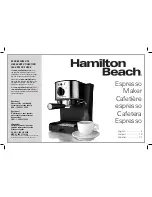
17
English
TIPS FOR GREAT RESULTS
What is espresso?
Overextraction and underextraction
Before brewing: the elements of great espresso
Espresso began as an attempt in the 1800s
to quickly brew coffee on demand, by the
cup. The goal was to serve the freshest,
most flavorful coffee possible and avoid the
burned, stale taste of coffee kept warm on
a stovetop. To speed the brewing process,
coffee pioneers struck upon the idea of
forcing water through the grounds under
pressure. Steam was initially used to supply
the pressure, followed by compressed
air, lever operated pistons, and finally, the
electric water pump.
Through the decades, the elements of
espresso brewing were tested and refined
Brewing great espresso takes an understanding
of what actually winds up in the cup when
coffee is exposed to water. Roughly 30%
of a roasted coffee bean is made of water
soluble compounds. 20% of those compounds
dissolve fairly easily, while the remaining 10%
take a little more work – which is a good
thing, because that less-soluble 10% is acidic,
bitter, and generally unpleasant. The goal of all
coffee making is to extract the easily dissolved
oils and compounds while leaving the rest in
the grounds.
If ground coffee steeps in water too long,
all the soluble compounds will be extracted,
which makes for a very bitter brew. This
Before the espresso machine is even plugged
in, you’ll need several elements to produce
great coffee.
Fresh Coffee Beans
Great coffee can only come from fresh
coffee beans, properly roasted. Many
baristas recommend buying beans roasted
no darker than a medium roast, the color of
which appears as an even chocolate brown.
This roast preserves the natural sugars and
flavor of the bean, which sets the stage for
excellent espresso. A medium roast is the
darkest a bean can be roasted without oils
developing on the surface.
Darkly roasted beans – which appear dark
to produce the standards we have today:
one ounce of true espresso comes from
exposing 1/4 ounce (7 grams) of finely
ground and packed coffee to 195–205º F
water under 130 lbs. (9 bars) of pressure.
In a brief 25 seconds, most of the highly
flavorful coffee aromas and oils are
extracted, while the more bitter compounds
and off-tastes are left behind.
When the ground coffee is fresh and the
brewing is done well, the pressurized brew
water emulsifies the coffee oils into the
golden foam called crema, which crowns the
espresso shot with ultimate flavor and aroma.
is called overextraction. The opposite of
overextraction is underextraction, which
occurs when coffee is not exposed to
the brew water long enough, leaving the
essential flavors and aromas locked in the
grounds. Underextraction results in coffee
that is weak in taste.
Whether brewed coffee is overextracted,
underextracted, or just right depends on
several factors, including the ratio of coffee
to brew water, the fineness of the grind, the
brewing temperature, and the length of time
the water is in contact with the coffee. All
these factors are either directly or indirectly
affected by the barista’s technique.
brown or nearly black – look great, but the
extra roasting overwhelms the more delicate
coffee flavors and caramelizes any sugars. A
heavy “roasted” coffee flavor, often bitter
and sharp, will predominate with a dark
roast.
To preserve the freshness of
coffee beans:
Keep beans in an opaque, air-tight container
and store them in a cool, dry place.
Refrigeration is not recommended, as
condensation tends to form on the beans
whenever the container is opened. Freezing
can help preserve beans stored for an
extended period, but it will also impair flavor.
















































